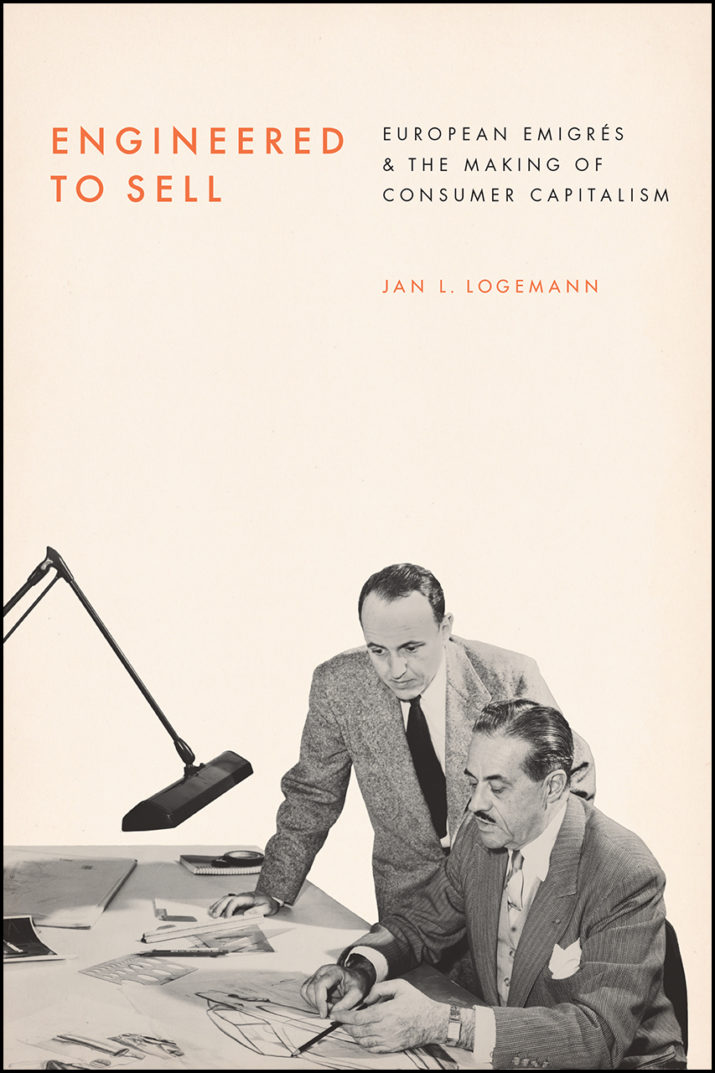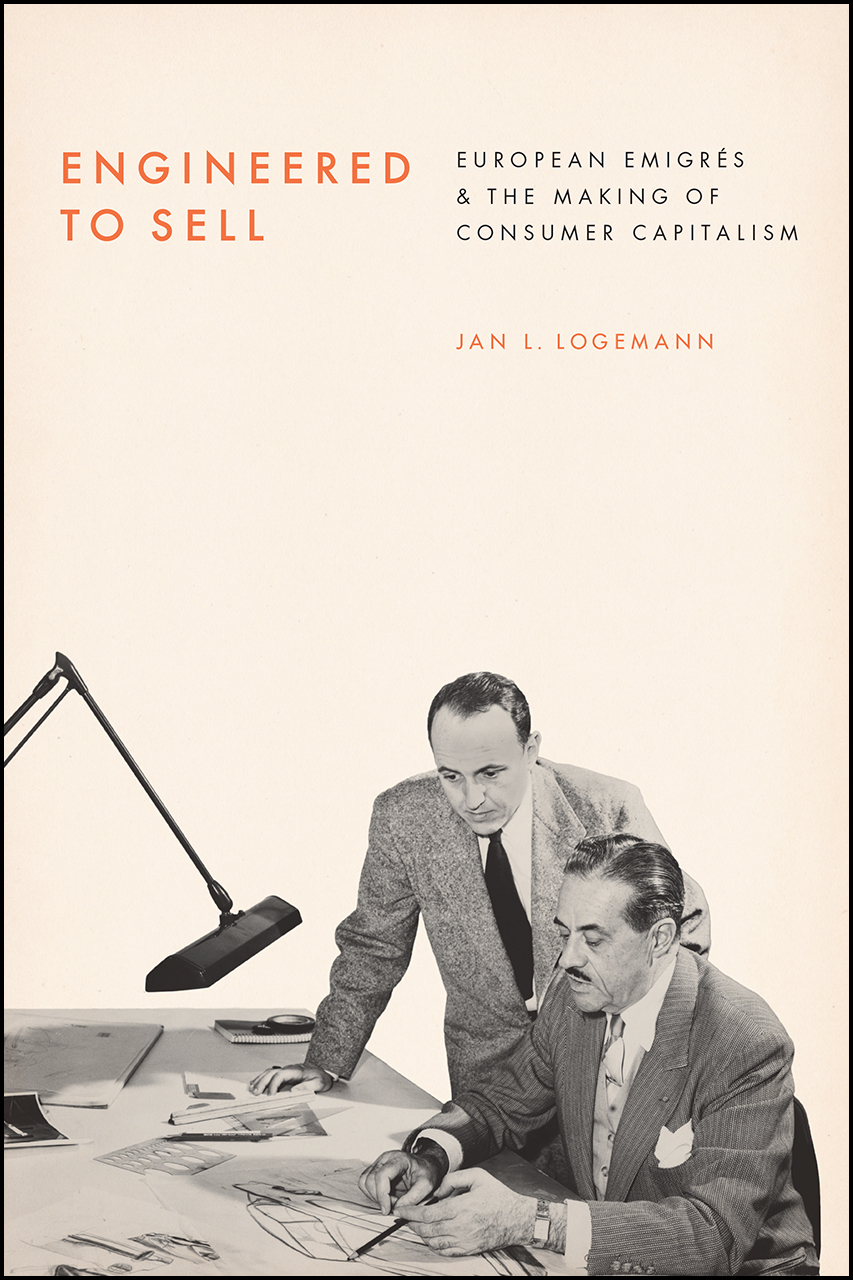
Engineered to Sell: European Emigrés and the Making of Consumer Capitalism by Jan L. Logemann
 This is part of our special feature, Imagining, Thinking, and Teaching Europe.
This is part of our special feature, Imagining, Thinking, and Teaching Europe.
There is an inherent fatalism in the term “interwar.” Yet, it remains a convenient descriptor for historians of the twentieth century. The new republics that replaced the old empires in Europe fleetingly demonstrated that liberal institutions and social democracy were possible, but their subsequent descent into intolerant nationalism, fascism, war, and ultimately the horrors of the Holocaust permanently tainted the period as a mere way station on the road to another civilizational collapse. However, simultaneous with this grand political narrative of weak institutions and looming catastrophe were multitudes of other interwar narratives of ordinary and extraordinary people whose lives were determined by events beyond their control, but whose actions in many ways did just as much to shape the extra-political dimensions of ordinary, daily life in the postwar world.
It is the task of historians to rescue such stories from ephemeral diffusion to create new narratives. A fascinating new study by Jan Logemann weaves together the biographies of a loosely connected group of European professionals working mostly behind the scenes in the fields of marketing, consumer psychology, and industrial design. Central to their story was an experience of interwar emigration to the United States, where they would fashion the consumer societies that flourished especially in the postwar period. Engineered to Sell follows thematically from Logemann’s previous monograph, Trams or Tailfins?, which compared the role of the state in creating qualitatively different consumer societies in postwar West Germany and the United States. The new work maintains this interest in “transatlantic” consumer history, but adopts what Logemann calls an “actor-centered approach.” Rather than focusing on state policies, Logemann turns his attention to the novel ideas and useful inventions of a group of figures he calls “consumer engineers” and “knowledge entrepreneurs.” These European émigrés worked mostly as consultants in the private sphere in the US to shape both the minds of consumers and the “world of goods” they occupied.
Logemann also employs a “transnational” perspective to provide a historiographical corrective to what he calls the “Americanization” paradigm of twentieth-century dominance in the fields of consumer marketing and retailing represented by authors such as Victoria de Grazia. While American-style mass consumption appeared to be the “dominant global model,” Logemann argues that émigré experts served as “transatlantic cultural intermediaries” in building consumer societies in the US and in Europe. Logemann admits that “Americanization” in the minds of Western Europeans typically applies to largescale state initiatives such as the Marshall Plan, but in his zeal to claim a scholarly intervention he may somewhat overstate the salience of this paradigm. Still, Logemann is right to point out that many of the features of the stereotypically “American” consumer society were in fact engineered by European émigrés who arrived during the interwar years. Ultimately, he makes the case that the history of consumer societies in the US and Europe is “multidirectional” and defined by transatlantic exchanges, connections, transfers, and circulations of knowledge. This is undoubtedly true, but the overall effect of Logemann’s multidirectional method of argumentation can be disorienting in its deviation from the chronological progression that one typically expects from narrative histories. Logemann’s approach is eminently clear and coherent, and yet, it occasionally delegates to the reader the historian’s task of reconstructing a chronology of cause and effect.
Logemann, who directed a research project at the German Historical Institute on the “Transatlantic Perspectives” of European immigrants before assuming his current position as Wissenschaftlicher Mitarbeiter at the University of Göttingen, draws on an impressive array of primary-source research conducted over several years in dozens of archives in the United States and Europe. Combing this archival research with an extensive reading of trade journals, esoteric industry sources like market research reports, and secondary literature, he uncovers the stories of some of the most prominent émigrés among the midcentury “consumer engineers” in the US. Some served as a nexus of innovation in their respective field, such as the Austrian sociologist Paul Lazarsfeld and his cohort of émigré social researchers, whose methods of market research would be incorporated into standard business practices. European advances in psychology were often key to the émigrés’ conceptual innovations, such as the idea of an individual’s “frame of reference” in relation to the social group, developed by the German Gestalt psychologist Kurt Lewin. The Austrian psychologist and marketing consultant Ernest Dichter, meanwhile, became infamous for his Freudian-tinged brand of “motivation” research. Europeans also introduced innovations in survey research, such as the German Alfred Politz’s random samples and the “consumer sentiment” polling introduced by the Hungarian behavioral economist George Katona. Émigrés were also major figures in the field of design. Most prominently, the French industrial designer Raymond Loewy became well known for his “streamlining” technique, which was applied to all manner of consumer products. The German industrial designer Ferdinand Kramer provided elegant furniture and fixtures for working-class homes, while the German packaging expert Walter Landor made a science of corporate branding. On the recommendation of Bauhaus founder Walter Gropius, the Hungarian artist-educator László Moholy-Nagy established a “New Bauhaus” design school in Chicago in 1937, which exists today as the Institute of Design. European design not only made waves in the consumer sphere, but also in corporate offices, such as the “international style” developed by Knoll Associates, the company led by the German Hans Knoll and his American wife Florence. Typically based in metropolitan centers like New York and Chicago, these émigrés literally reshaped the American consumer landscape over the course of their careers. Some returned to Europe and made a significant impact there as well. Lazarsfeld, for example, was instrumental in the 1963 founding of the Vienna Institute for Advanced Study, which would become an important venue for the reintroduction of “American” styles of social science in Europe.
In addition to these principal figures, there is a large cast of supporting characters with immigrant backstories, and Logemann is careful to identify everyone’s country of origin and usually the year of their immigration to the US. One of the ironies of this “transnational” approach, however, is that the essentially cosmopolitan character of these careers in international business becomes defined by the experience of emigration from the home country. Paradoxically, this is their qualification for inclusion in this narrative, but Logemann’s main interest is not their story of emigration but rather the condition of having emigrated. In that sense the word “émigré,” derived from the French past participle, is the perfect description. Logemann is so eager to get his characters in their places as émigrés that their emigration stories are often dispensed with in a paragraph or even a sentence. Indeed, there is no common story of emigration that would justify lumping these figures, who came to the US from different countries at different times for different reasons. Some, such as Lewin, were forced to leave Germany after Hitler’s rise in 1933. Others, such as Dichter, fled Austria after the Anschluss in 1938, when the Nazi regime made their careers impossible because of their identity as Jews or socialists. Still other stories of emigration were not so neat. Lazarsfeld, for instance, was a Jewish socialist, but he first came to the US as a Rockefeller fellow and stayed on when the rise of pre-Anschluss Austro-fascism shattered his career prospects in Vienna. Some were neither Jews nor socialists, but merely disliked the Nazi regime and emigrated by choice to advance their careers in the US. Loewy was even more exceptional, emigrating from France as a young man shortly after World War I.
Despite these differences, the chosen professions of Logemann’s émigrés shared a common cosmopolitan character. It is not coincidental that a future-oriented school of modern design with a nationally diverse student body like the Bauhaus alerted the Nazis to a specifically non-German, international “cultural Bolshevism” that was antithetical to their backwards-looking, hyper-nationalist project. The artistic and ideological movements that the émigrés were often associated with were in many ways more properly speaking supranational than transnational. Logemann hints at this not only in his aversion to the paradigm of “Americanization,” but also in the biographical aspects he chooses to focus on, which for the most part privilege professional training over social context, national culture, or familial upbringing. Although Logemann makes frequent reference to the vaguely defined “social reform” movements that occupied many of these figures in their home countries before their emigration from Europe, he tends to view this past political involvement not as logically consistent but as contradictory to their later work as consumer engineers. Ultimately, what Logemann presents is less a migration story about the meaning of national origins than it is a business history of international networks of knowledge exchange that uses the careers of a relatively privileged set of émigrés as case studies. The fact that most of these figures arrived and thrived in the US during the period of immigration restriction further indicates that their membership in an emerging international business elite was often a more salient characteristic than their country of origin.
As a business history, Logemann’s book is excellent. It is an important contribution to our understanding of the ways in which international networks and small business consultancies (“startups,” in today’s parlance) used a range of modernist design techniques and social science research methods to engineer the postwar Keynesian consumer societies that fueled the Trente Glorieuses in Europe and the US. Logemann’s analytical method especially succeeds in transcending the temporal tautology of the “interwar” years when viewed through the prism of political history. True to his business history approach, Logemann makes much use of the terminology of transatlantic or transnational connections, circulations, and exchanges. In a world of globalized economic relations, this kind of decentered, non-national language is very appealing, but it has the unfortunate side effect of suggesting that the world of business does not belong within history but rather exists beside it. Extracted chronologically, Logemann’s book has the profound potential to demonstrate that the lesser-known economic-cultural modalities of interwar displacements and migrations were in many ways as consequential for shaping quotidian life in the postwar years as were the better-known political realignments that would lead to the Cold War.
Joseph Malherek is the Junior Botstiber Fellow at the Institute for Advanced Study at Central European University in Budapest. His research focuses on intellectual migrations, the history of capitalism, and American consumer culture in a transatlantic context. He has a Ph.D. in American Studies from George Washington University, and has been a Fulbright visiting professor at the University of Vienna.
Engineered to Sell: European Emigrés and the Making of Consumer Capitalism
By Jan L. Logemann
Publisher: University of Chicago Press
Paperback / 380 pages / 2019
ISBN: 9780226660158
References:
de Grazia, Victoria. Irresistible Empire: America’s Advance through Twentieth-Century Europe. Cambridge: Belknap Press of Harvard University Press, 2005.
Logemann, Jan L. Trams or Tailfins? Public and Private Prosperity in Postwar West Germany and the United States. Chicago: University of Chicago Press, 2012.
Published on June 3, 2020.




